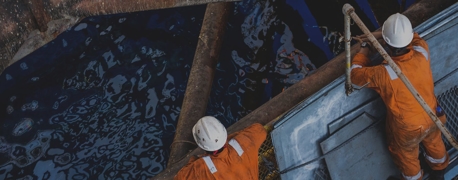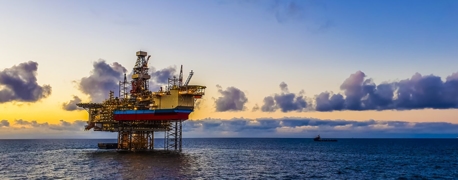What Families Need to Know About the Death on the High Seas Act (DOHSA)

Why would anyone need to know about a law that’s almost as old as the Titanic itself? Even though the Death on the High Seas Act (DOHSA) has changed very little since it was first enacted in 1920, for some families, it’s the only option they have to hold negligent companies responsible for the death of their loved one. DOHSA was originally created in part as a response to the Titanic, particularly as a help to families who had lost their breadwinners so they could recover financial compensation accordingly. Nowadays, it unfortunately has served the interests of negligent companies by limiting what families can do to seek justice and compensation for a loved one who has died in international waters.
Why DOHSA Was Needed
Back when the Titanic sank (1912) and later the Lusitania (1915), families who lost loved ones in those disasters had no legal route for compensation. No state or federal laws applied to wrongful deaths out on the high seas. With the Death on the High Seas Act, families could file for compensation for maritime accidents that occurred outside of U.S. waters due to shipowner negligence or the vessel being unseaworthy.
These families could now file for economic damages, that is, they could demand enough compensation to make up for the loss of the deceased person’s financial support. There was no provision for non-economic damages, such as pain and suffering and loss of companionship.
Some of the most common forms of negligence that can lead to a DOHSA lawsuit include and aren’t limited to:
- Sunken or capsized vessel
- Equipment or machinery malfunctions
- Fires/explosions onboard
- Failure to train staff
- Not providing adequate medical treatment
International waters or the high seas were originally designated as starting “a marine league” out from U.S. shores, about 3.5 miles. That includes the shores of U.S. territories. Today DOHSA applies to waters 3 nautical miles out from U.S. shores for ships and other vessels (we’ll get to the commercial flight exception shortly).
The Good News: DOHSA Can Still Help Families
While the Jones Act covers a range of personal injury and wrongful death cases for seamen, this law doesn’t help the families of passengers and other non-seamen who perish on the high seas, whether on aircraft, cruise ships, or other maritime vessels. Under DOHSA, these families have legal options for pursuing a measure of justice and compensation, even if it is only for economic damages. This act also still covers workers who are killed on maritime vessels three miles out from U.S. shores, or commercial flights twelve miles out form U.S. shores.
Commercial Flight Accidents & DOHSA
Twelve minutes after takeoff on July 19, 1996, Trans World Airlines (TWA) flight 800 suffered an explosion, sending the plane and all 230 people on it into the Atlantic, about eight miles away from Long Island, New York. It took 15 months of painstaking recovery and more than four years of investigations and analysis before it was determined that the Boeing aircraft’s fuselage had separated from the plane after a wire in the fuel tank short-circuited, leading to the explosion. The crash was the result of outdated equipment, especially aging wires, and a faulty fuel tank design.
Two difficulties confronted the families who were trying to file wrongful death claims after this tragic accident, which was clearly the result of negligence. First, because the flight was downed beyond the 3-mile perimeter for U.S. waters, New York laws and federal laws were determined to not apply, so families had to turn to DOHSA to file a claim. This meant only economic damages could be asked for.
This presented an even more grim challenge to the parents of the 16 teenagers who had perished in the crash. Because they were students who weren’t bringing in a paycheck, they represented no loss of financial support, so a DOHSA claim would yield nothing.
In response to this, Congress officially amended DOHSA, creating Section 30307 to provide an exception for commercial flights. This amendment (which was applied retroactively to help the families affected by TWA 800) meant that anyone filing a wrongful death claim for someone killed on a commercial flight that was 12 miles or more out from shore could now file for non-economic damages as well as economic losses.
Under this exception, surviving family members of those killed in commercial flight crashes on the high seas can file for:
- Loss of care,
- Loss of comfort, and
- Loss of companionship
Shortly before this exception was made, however, international waters for commercial flight accidents were determined to start at 12 miles out from shore instead of three. This meant that the family members could file wrongful death claims under applicable state laws instead of DOHSA, which could also allow for punitive damages.
The Bad News: The Limitations of DOHSA
With wrongful death claims, families can usually demand compensation for their loved ones’ pain and suffering before death as well as their own loss of companionship and other noneconomic damages. Under DOHSA, families can only recover economic damages, such as lost financial support and sometimes funeral expenses. In other words, if the loved one who died was earning wages, the surviving relative(s) could recover financial compensation to make up for the lost financial support.
The only people who can file DOHSA claims include the deceased person’s:
- Spouse,
- Parent,
- Child,
- Or other relative who is a dependent
If a stepchild or a financially independent sibling or other relative tried to file a DOHSA claim, they wouldn’t have a case because they wouldn’t be considered a close enough relative and/or not dependent on the deceased person’s income.
Unfortunately, that also means that if the deceased person was a child, retiree, or otherwise unemployed person, they don’t present a loss of financial support for anyone, which also means that with DOHSA, no surviving family member would have a case to try to hold the negligent parties accountable for the wrongful death.
Contributory Negligence Applies in DOHSA Cases
Another issue that can crop up in these cases is that of contributory negligence, which decreases the amount of compensation available to surviving family members. Under this rule, if someone is considered partially at fault for the fatal accident, then whatever percentage of fault is assigned to them is the percentage by which compensation would be reduced.
Challenges for Commercial Flight Accidents
The exception for commercial flights under Section 30307 did not take care to specify what counts as a commercial flight.
This became an issue in a 2009 court case, Eberli v. Cirrus Design, which involved a deadly airplane crash that occurred 12 miles out from U.S. shores. This distance meant that even though the crash was because of airplane defects, the family didn’t have the option of filing a wrongful death claim against the manufacturer. They could only turn to DOHSA. Even though the crash involved a commercial pilot transporting the plane to an international buyer, the courts decided that this didn’t count as a commercial flight accident, and so a DOHSA claim wasn’t viable either.
In another case, however, a different court sided with the plaintiffs. In this 2021 case, Horsely v. Bell Textron, a commercial pilot had been flying oil rig employees to and from work in the Gulf of Mexico when the flight crashed on the high seas. The defendants tried to argue that only large passenger flights like TWA 800 were meant to be covered by the commercial flight exception, but this time the court determined that the doomed flight was a commercial flight, and as such, surviving family members could file for economic and non-economic damages under DOHSA.
The Frustrating Reality: DOHSA Helps Negligent Companies Avoid Liability
DOHSA can be some families’ only option for legal action after a tragedy, but it can also be something that companies hide behind in order to avoid taking responsibility for their own negligence. To this day, if someone who isn’t a seaman dies because of negligence or a wrongful act on the high seas, including a retiree or a child on a cruise ship, then family members might only have a DOHSA claim as a legal option.
Through this, they would only be able to recover funeral and burial costs, if that. Only certain family members can file suit under DOHSA, and punitive damages are not possible in any type of case. This limits a family’s options for compensation enough that it is often the negligent companies involved that bring up DOHSA, using it as a shield against having to pay much or anything at all, while families are trying to see if they can use state or federal laws instead to bolster their chances of holding a negligent company accountable.
Attempts to Update DOHSA: Hammer’s Law
On April 10, 2016, retired couple Larry and Christy Hammer had just started a cruise in Peru. They had been given a faulty electrical extension cord to use for Larry’s respirator. This wire short-circuited around 2AM, starting a fire while the couple was asleep. No smoke or fire alarm went off. Video footage shows that the crew onboard had noticed the smoke coming from the couple’s room, but they can be seen frittering away 20 critical minutes, bewildered about what to do, even trying to open the couple’s door but immediately closing it when met with a wall of smoke. Mostly they loitered, talked, left, and came back, all rather aimlessly. When the staff finally decided to pull Larry Hammer out of the room, he was already dead from smoke inhalation. It wasn’t until six minutes after this that Christy Hammer was finally pulled out of the smoke-filled room, and she was pronounced dead while being transported to the hospital. Peru’s navy found that the cruise company was negligent in its defective fire alarms, bad power strip, and the crew’s inaction.
The investigation also found that crew members were not certified for the jobs that they held, and that they had not received training for their work or on safety procedures. The staff seemed to act with no regard for the couple’s well-being, either. Despite the fact that the cruise company advertised that their vessels surpassed Peru’s safety standards, reports found that they had seriously violated a host of regulations. This was, without a doubt, a clear case negligence that had tragically cost a couple their lives.
Their daughters tried to file a wrongful death claim through Delaware state law, since the cruise tickets had a Delaware contract in it. Unfortunately, the cruise company has so far been able to hide behind DOHSA instead, leaving the Hammers’ daughters trying to seek funeral costs through DOHSA.
In response to this tragic situation and DOHSA’s restrictions on grieving families, a bill known as Hammer’s Law has been introduced multiple times. If Hammer’s Law ever gets passed, it would mean that surviving family members could file for noneconomic damages as well as economic damages. Just like in the commercial flight exception to DOHSA, this would allow those who lost loved ones on the high seas to seek compensation for loss of care, comfort, and companionship in addition to any financial losses incurred by the preventable tragedy.
The Fairness for Fallen Sailors Act
The Fairness for Fallen Sailors Act is another bill that has yet to pass, but it would allow additional parties to file a DOHSA claim while also expanding the type of compensation available in cases where sailors die on the high seas. Specifically, it would also allow the representative of the deceased person’s estate to file a DOHSA claim and go after “the person or vessel responsible.”
In cases where a sailor dies due to negligence, a wrongful act, or on the high seas, the plaintiff could seek compensation for:
- The deceased person’s pain and suffering
- Their family’s loss of care, comfort, and companionship
Again, this law would expand the exception provided for commercial flight accidents to apply to more wrongful deaths on the high seas.
The Future: Will DOHSA Be of More Help to Families or to Companies?
While the Death on the High Seas Act has proven helpful for some families when they’ve suffered devastating personal and financial losses after a maritime or commercial flight accident, the law has barely received any updates, and even those have proven to be piecemeal, inadequate measures. This means that a tragic accident in international waters can quickly become a legal maze that leaves surviving relatives with little to no legal options. It remains to be seen if DOHSA will help negligent parties avoid taking responsibility for deaths that they could have prevented, or if meaningful changes to DOHSA mean that it can better help grieving families put the pieces back together again.


